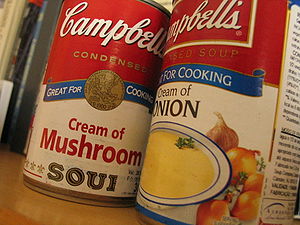February is National Canned Food Month, when we can celebrate and be thankful for the wide array of food products available in canned versions. For many consumers, canned food offers a way to expand the kinds of food they eat all year round without increasing their budget. Mixing fresh Arizona produce, pork, beef, and chicken with canned fruits, vegetables, beans, and other items can help boost your nutritional intake, fill your plate with fabulous food, and stretch your food dollar a little farther.
History
The concept of canning food in order to preserve it for later use has been around for more than 200 years. During the Napoleonic Wars, the French found a way to use glass jars to preserve large quantities of food and transport it over long distances to feed the soldiers. It didn’t take long before glass jars were replaced by canisters made from wrought-iron and tin for practical reasons. These canisters are the basis for what we refer to as cans today. As the population in the western world began to shift from rural areas and farms toward urban centers, improvements in canning food offered a way to feed people as they moved farther and farther from the source of their food.
Safety
A key consideration from the first can of beans to today’s table is food safety. Today’s canneries operate under strict regulations put in place to ensure the safety of the canned goods produced. The best way to be safe is to follow the recommendations of the USDA’s Food Safety and Inspection Service which says:
- Don’t eat canned goods that have been exposed to high temperatures (100 degrees Fahrenheit).
- After opening the can, store unused canned goods in plastic or glass containers in the refrigerator for maximum safety.
- Avoid eating food from cans with deep dents or dents along the seams of the can.
- Don’t eat canned goods that have frozen and thawed or refrozen on their own.
- Never eat food from a can that appears swelled or is leaking.
- Don’t eat canned goods that smell or look unusual.
- If you can food at home, follow all necessary safety precautions for the type of food you are preserving.
- Check home-canned jars for cracks, swelling, loose lids, foul odors, and milky liquids before eating. If any of these are present, do not eat the food.
Recipes
- Ranch Beans and Chicken featuring canned beans
- Tamale Pie featuring canned corn, chilies, and olives
- Baked Corn Dish featuring canned creamed corn and chilies
- Cha Cha’s Chili Corn Bread featuring canned corn, creamed corn, and green chilies
- Hearty Hamburger Stew featuring canned tomatoes and okra
- Rice Quiche featuring canned evaporated milk
- Comforting Corn Chowder featuring canned chilies and cream of mushroom soup
- BBQ Chili Pasta using canned Corn
- Sausage and Bean Slow Cooker Dinner featuring canned beans, beef stock, and tomatoes
- Hot and Spicy Spinach Artichoke Dip featuring canned artichoke hearts
- Slow Cooked Creamy Chicken Tortilla Soup featuring canned beans and cream of chicken soup
- Salsa Verde Pork and Pepper Stew featuring canned salsa verde
- Tuscan Style Pasta with Cannellini featuring canned beans and tomatoes
- Macaroni and Cheese Primavera featuring canned green beans, mushrooms, and tomatoes
- Linguine in Spicy Red Clam Sauce featuring canned clams, anchovies, tomatoes, and olives
- Southwest Black Bean Cobb Salad featuring canned beans, tomatoes, and corn
Related articles
- Let Soup Warm You this Winter (fillyourplate.org)
- Baked Beans: An American Original (fillyourplate.org)


